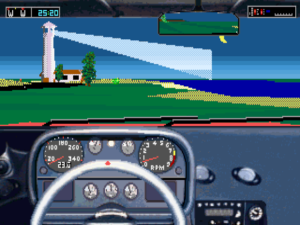Written by: Stoo
Date posted: January 7, 2020
I can’t say I wasn’t warned – Rik gave this game 2/10 and specifically recommended its predecessor instead. Still, I felt an odd compulsion to try it anyway.
Here’s why: Test Drive 3 presents you with a three dimensional rural landscape full of hills, trees, roads and farms. It’s just the sort of place you scenic place you might visit in real life, or even live nearby to if you’re lucky. It then lets you move around this world with a high degree of freedom.
It wasn’t necessarily the first game to ever do this, but it was one of the first I encountered personally. Truly 3D worlds like this were not at the time all that commonplace. Action games were still for the most part firmly 2D. RPGs were still either mostly overhead view (Ultima), or 3D approximations based around primitive tile set dungeons (Wizardry, Eye of the Beholder). Flight sims were 3D, I suppose, but lacking ground detail seeing as you were mostly zooming around far above.
As for other driving games, such as Outrun or indeed Test Drive 2, they weren’t quite proper 3D. You couldn’t turn around, or leave the road. The accessible world was a narrow tunnel with transparent walls; any object set back from the road was not a real thing, just a decoration that slid past to one side. Here in TD3, however, you can drive into the grass and park in front of a house. Sure there’s no reason to, but that doesn’t matter. Simply the fact that you can do such a thing makes the world more convincing.
So, to bring my own thought processes in convergence with Rik’s comments, Test Drive 3 provides the chance to go for a drive cross-country in a real car. That’s an actual highway you’re travelling down, green scenery around you, and a station wagon in your way doing 50mph. Then of course, you can make the windscreen wipers go, and such a minor detail suddenly feels like an essential feature of proper driving.
Of course, this was 1990, and now all looks rather primitive. 3D engines were in their infancy, which is exactly why not many games outside of simulators were using them. So the cars and scenery are built out of very simple shapes. Myself, I have a particular affinity for this sort of early 3D, but it won’t be everyone’s cup of tea.
Unfortunately, as much as I wanted to enjoy a drive around the Yosemite, I struggled with the controls. In fact after a couple of minutes of my first attempt, I had crashed about twelve times into trees, cars and plunged into the water twice. I think I hit a cow also.
Now, I’m bad at racing games at the best of times, that’s why I don’t write about them a lot. Still, it does seem like you need an exceptionally light touch on the steering wheel, to avoid acute oversteering. So the more twisty parts of the track led to swerving back and forth until inevitably smashing into a tree. It was reassuring to refer back to the original review and see that Rik also found the handling to be twitchy, since he’s far more experienced with this genre.
Eventually I decided to just enjoy the ride and do anything tricky at a sensible 50mph or lower. I did manage enough speed to get several speeding tickets, but by then had long given up on caring about what sort of times I set. In fact at one point I parked up near a lighthouse just to take screenshots. The road was completely empty of other cars by then, which is probbaly a sign that I was taking too long.
I found this provided a reasonably entertaining evening, while playing on my Surface in front of the TV (an ideal, if pricy retro-gaming platform). That said, I was mostly just goofing around. If you were to play seriously for any length of time, I can see how this would become frustrating and tedious. So I have no particular reason to challenge Rik’s criticisms, but I reckon it’s worth a brief look if you’re interested in early implementations of open-world driving.


 Posts
Posts